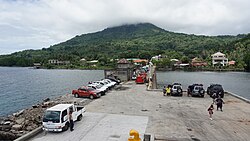
Back Propinsi Camiguin ACE كاميغويين Arabic کامیقوئین AZB Camiguin BCL Camiguin CBK-ZAM Camiguin CEB Camiguin German Kamigino Esperanto Camiguín Spanish کامیگوئین Persian
Camiguin | |
|---|---|
(clockwise from top) Timpoong and Hibok-Hibok Natural Monument, Ferry in Camiguin, Guinsiliban Port, and Camiguin Circumferential Road | |
| Motto: The Island Born of Fire[1] | |
 Location in the Philippines | |
| Coordinates: 9°10′N 124°43′E / 9.17°N 124.72°E | |
| Country | Philippines |
| Region | Northern Mindanao |
| Founded | 1565 |
| Provincehood | June 18, 1966 |
| Capital and largest municipality | Mambajao |
| Government | |
| • Governor | Xavier Jesus D. Romualdo (Lakas) |
| • Vice Governor | Rodin M. Romualdo (PFP) |
| • Legislature | Camiguin Provincial Board |
| Area | |
• Total | 241.44 km2 (93.22 sq mi) |
| • Rank | 80th out of 81 |
| Highest elevation | 1,630 m (5,350 ft) |
| Population (2020 census)[3] | |
• Total | 92,808 |
| • Rank | 80th out of 81 |
| • Density | 380/km2 (1,000/sq mi) |
| • Rank | 17th out of 81 |
| Divisions | |
| • Independent cities | 0 |
| • Component cities | 0 |
| • Municipalities | |
| • Barangays | 58 |
| • Districts | Legislative districts of Camiguin |
| Time zone | UTC+8 (PST) |
| IDD : area code | +63 (0)88 |
| ISO 3166 code | PH-CAM |
| Spoken language | |
| Income classification | 5th class |
| Website | www |
Camiguin, officially the Province of Camiguin (Cebuano: Probinsya sa Camiguin; Tagalog: Lalawigan ng Camiguin; Kamigin: Probinsya ta Kamigin), is an island province in the Philippines located in the Bohol Sea, about 10 kilometers (6.2 mi) off the northern coast of mainland Mindanao. It is geographically part of Region X, the Northern Mindanao Region of the country and formerly a part of Misamis Oriental province.
Camiguin is the second-smallest province in the country in both population and land area after Batanes.[4] The provincial capital is Mambajao, which is also the province's largest municipality in both area and population.[5]
The province is famous for its sweet lanzones, to which its annual Lanzones Festival is dedicated and celebrated every third weekend of October. It is home to lush interior forest reserves, collectively known as the Mount Hibok-Hibok Protected Landscape, which has been declared by all Southeast Asian nations as an ASEAN Heritage Park. The province also boasts three National Cultural Treasures, namely, the Old Bonbon Church ruins in Catarman, the Sunken Cemetery of Catarman, and the Spanish-era watchtower in Guinsiliban. The three sites were declared for “possessing outstanding historical, cultural, artistic and/or scientific value which is highly significant and important to the country and nation.”
Additionally, the island province has numerous Important Cultural Treasures, such as the Old Mambajao Fountain - situated in the town's rotonda, the Old Mambajao Municipal Building, the façade of the Santo Rosario Church in Sagay, and 14 heritage and ancestral houses. The sites were declared for “having exceptional cultural, artistic and historical significance to the Philippines.” All cultural treasures were declared by the National Commission for Culture and the Arts. There have been moves to establish a dossier nomination for the province to be included in the UNESCO World Heritage List.[6]
Camiguin is sometimes called Camiguin Sur ("South Camiguin") or Camiguin de Mindanao to distinguish it from Camiguin de Babuyanes of the Babuyan Islands, which in turn is referred to as Camiguin Norte ("North Camiguin"). Both are volcanic islands.[7][8]: 55 [9]
- ^ Montalvan II, Antonio J. (January 26, 2015). "London travel fair gets an exciting glimpse of Camiguin, 'island born of fire'". Philippine Daily Inquirer. Retrieved March 18, 2016.
Among the exhibitors from the Philippines this year is the island province of Camiguin in Mindanao that calls itself "the island born of fire."
- ^ "List of Provinces". PSGC Interactive. Makati City, Philippines: National Statistical Coordination Board. Archived from the original on January 11, 2013. Retrieved January 30, 2013.
- ^ Census of Population (2020). "Region X (Northern Mindanao)". Total Population by Province, City, Municipality and Barangay. Philippine Statistics Authority. Retrieved July 8, 2021.
- ^ Cite error: The named reference
Aboutwas invoked but never defined (see the help page). - ^ "Province: Camiguin". PSGC Interactive. Quezon City, Philippines: Philippine Statistics Authority. Retrieved January 8, 2016.
- ^ "Camiguin church ruins, Sunken Cemetery declared National Cultural Treasures". Inquirer Lifestyle. December 16, 2018.
- ^ Fotolulu (2018). Taxonomy of the Birds of the World The Complete Checklist of All Bird Species and Subspecies of the World. BoD – Books on Demand. pp. 388, 424. ISBN 9783748165699.
- ^ Becker, George Ferdinand; Martin, Karl (1901). Report on the Geology of the Philippine Islands. U.S. Government Printing Office.
- ^ "Camiguin island". BirdLife International. Retrieved January 22, 2024.






